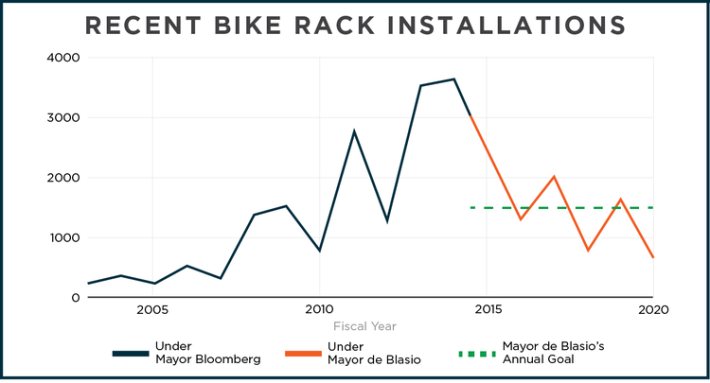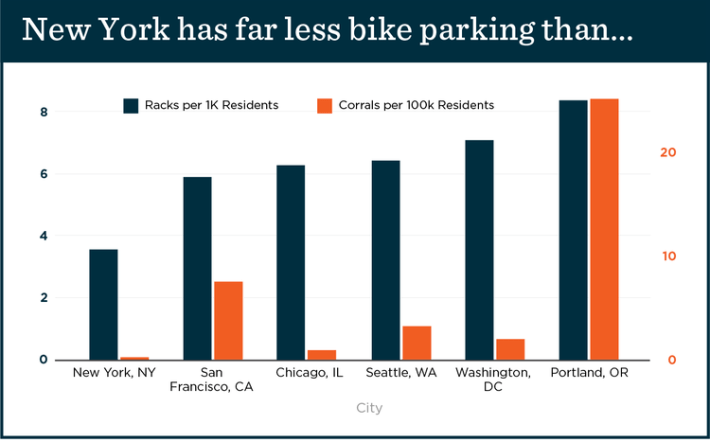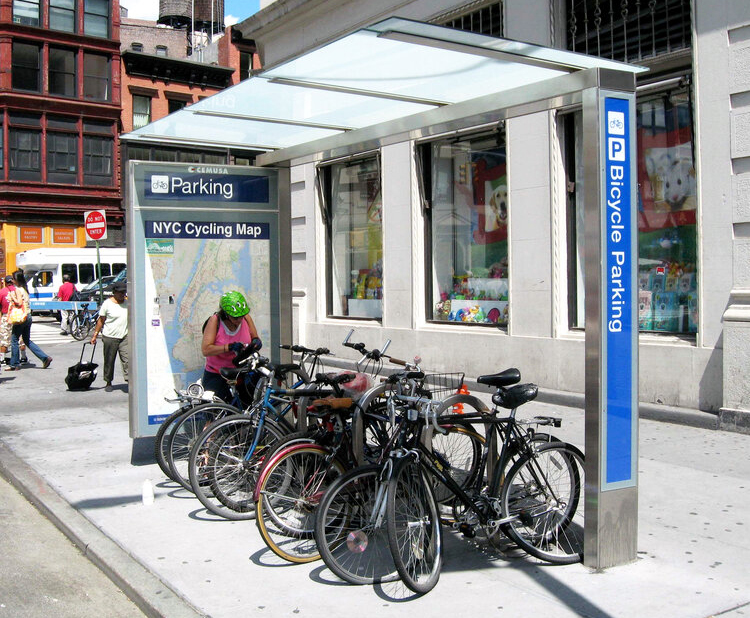For want of simple, widely installed bike racks, the city is undermining local businesses, abetting a rise in bike theft, slowing the use of bikes for commuting or errand running, and even undermining public safety, a new report argues.
According to Transportation Alternatives, the de Blasio administration's installation of bike racks consistently fails to meet even its modest goal of 1,500 racks per year — far below the numbers achieved by the previous administration — and the result is a multi-faceted problem that goes beyond merely not having a place to lock a two-wheeler.
“Simply put, there is not enough bicycle parking in New York City,” Danny Harris, the group's executive director said in a statement timed to Tuesday's release of the report, "The Power of Bicycle Parking: An Easy, Affordable and Effective Way to Save Lives, Encourage Cycling, and Create a Fairer New York City."
“Despite more households owning bikes than cars, bike parking has taken a back seat to free private car storage on our streets," Harris added. "As more New Yorkers turn to bikes, our city needs to start building more bike parking now. Installing dedicated spaces at scale will send a strong signal that biking is safe, reliable, and accessible for all New Yorkers.”
The key findings of the 10-page report won't shock any cyclist who has struggled to find a place to lock a bike — nor will it surprise advocates who have been calling for action. But still, some parts of the report bear constant repeating:

- The city has failed to deliver on 11 plans to improve bicycle parking, including one to add 1,500 new bicycle parking racks a year (see chart, right). The lack of bike parking — cited in the city's own studies — is a main demand of cyclists and a key factor in encouraging more cycling, the TA report says.
- Only 67 bike corrals — which add roughly eight bike parking spaces in the footprint of a single car parking space — have been installed since the program began in 2011. Only 24 have been installed in the past five years, a result of the city's insistence that it needs a maintenance partner to assume liability over the rack.
- No bike corrals are located north of 65th Street in Manhattan, south or east of Prospect Park in Brooklyn, or in Staten Island. The Bronx has only two corrals. Thirteen off the top 20 neighborhoods with the highest cycling rates in the city have no bike corrals, TA said.
- In 2011, the city said it would build 37 bike parking shelters — which resemble bus stops, but have bike racks inside the three walls. Only 18 were built in the subsequent nine years.
- The lack of secure parking during an historic cycling boom has led to a 27-percent increase in bike theft, the Times reported.

As a result of the failure to create more bike parking, there are more than 100 free car parking spaces for every bicycle parking space in New York City, which trails other major cities per capita for this kind of infrastructure (see chart, right).
There is 1.5 parking space for every car registered in New York City, but only one bicycle parking space for every 116 estimated bicycles, the report states.
Politicians who care about sustainable transportation and livable streets rushed to embrace the report on Tuesday. Manhattan Council Member (and Borough President candidate) Ben Kallos evoked "what New Yorkers do to fit their bikes in tiny studio apartments," including hanging his "vertically in a bathtub."
"I fully support every recommendation from Transportation Alternatives and will work to make them a reality," Kallos told Streetsblog. "We've already partnered with residents to place bike racks throughout the district anytime they are requested. I am particularly interested in the climate-protected ... pods to protect bikes from theft."

Council Speaker Corey Johnson, who spoke of "breaking the car culture" before abandoning his run for mayor, added, "We can't be a bike-friendly city without more bike parking, and the Council will continue pushing for more as we recover from the pandemic. Bike parking is part of cycling infrastructure, just like protected bike lanes, and we need more of all of it to encourage cycling as a sustainable mode of transportation as we rebuild our city."
The failure of the city to create bike parking might seem insignificant to the larger failure of the city to bring cycling deaths down to zero, to create a safe network of bike lanes that would encourage a sustained cycling boom or to equitably disperse public benefits such as Citi Bike and protected bike lanes.
But, Transportation Alternatives argues, it's all related — and it all stems from the lack of bike parking, which 95 percent of cyclists say is important to them. As a result, the lack of bike parking discourages cycling — and fewer cyclists reduces the well-documented "safety in numbers" effect (while also providing a disincentive for the city to massively expand bike infrastructure). And insufficient bike parking leads to bike theft, which disproportionately affects the poor.
The threat of losing a bike to a thief is especially pressing on low-income communities and communities of color. A national survey from 2017 showed that only 32 percent of White respondents said that secure bicycle parking would increase their riding, but 47 percent of people of color indicated the same. In the same study, 45 percent of respondents who earned less than $30,000 per year said that access to bicycle parking would increase how often they ride, while just 30 percent of those earning more than $75,000 per year said the same. Clearly, low-income people are far more reluctant to choose a sustainable, cheap form of transportation out of concern for losing their wheels, which are often their form of transportation, not merely a mode of leisure.
But bike theft affects all victims. On Tuesday, Transportation Alternatives offered testimony of Dr. George Syros, a cardiologist at Mt. Sinai Queens:
At the height of the pandemic, I had relied on my used bike to commute more than four miles each way to Astoria, but during one hospital shift, my bike was stolen,” said . “Thanks to the Bike Match program launched by Transportation Alternatives, I was able to get another bike, but nobody should lose their reliable transportation option while dealing with the already challenging COVID situation. Many hospital workers are biking to work now, and secure bike parking needs to be significantly expanded to meet this growing need. I hope that the city improves in this area in 2021.
And a lack of bike parking undermines local businesses, according to TA, because cyclists end up spending more in shopping districts per meter of space their vehicles take up. A fascinating 2010 report out of Australia showed that drivers do spend more money when they go shopping (presumably because their vehicles can carry more), but cyclists take up far less room, so that the space taken up by the multiple cyclists who could fit in one parking space generated 3.6 times more spending than space taken up by the occupant of the one car. The authors of the study had removed two parking spaces to create 12 bike parking spaces. Even when the bike parking was less than 30 percent occupied, it still generated the same spending as the missing car spaces.
The TA report offers several concrete recommendations beyond the main one (build more bike parking!). The city should:
- start a massive expansion in bike parking in low-income communities and communities of color, paired with the expansion of Citi Bike and protected bike lanes.
- take road space from cars — as the city did with its successful open streets and open streets restaurants initiatives — and use bicycle parking to make intersections safer because a bike corral helps to daylight a corner.
- allow developers to create swap out cars for bike parking are part of the mandatory minimum number of parking spaces that are required in new developments because few apartment dwellers want car parking in a city where far more households have bikes than cars.
- eliminate the requirement for maintenance partnerships before the city will install a bicycle corral.
- embrace private bike parking companies such as Oonee, which claimed earlier this year that the city has ignored its proposals. The city had chosen to work with a different company on a facility that was supposed to open in April, but never did, as Streetsblog reported.
- do what London does: Through the "bike hanger" program, cyclists are charged about $7 a month for a secure space in the form of a low, smaller-than-a-sedan locker (see photo below). The program helped increase bicycle parking in London to 160,000 bicycle parking spaces overnight, TA said.

Particularly embarrassing for the de Blasio administration is the report's laundry list of the 11 failed efforts by City Hall to create more bike parking in the past eight years:
- In 2016, the city promised to build secure bicycle parking near major transit hubs and local commercial districts, starting with a pilot bicycle parking facility on the Manhattan side of the Williamsburg Bridge. None was built.
- In 2017, the city promised to build three secure bicycle parking structures that could each hold 29 bicycles. None was built.
- In 2019, the city promised to revamp the bicycle parking program with a community-based interactive bicycle parking suggestion portal and updated maps of existing bicycle parking; develop secure high-capacity class 1 bicycle parking structures using a shipping container design in both Brooklyn and Manhattan; install 1,500 bike racks and bicycle corrals annually, reaching 25 neighborhoods; seek private-sector bicycle parking operators to provide secure parking facilities citywide; and include high-capacity bicycle parking in major transit station projects, including the Port Authority Bus Terminal. None of these promises was kept.
- In 2020, the city announced that it would restart the bike corral program. But that did not happen.
Streetsblog reached out to the Department of Transportation on Monday afternoon with a full copy of the report. We received the following statement at 11:59 p.m. Monday:
DOT takes bike parking very seriously and, contrary to the report, has without question brought about a successful broadening of parking availability across the five boroughs, and done so facing Covid-related challenges which created operational challenges impacting several of our priorities.
We also assert that it’s more accurate to describe our efforts as fitting under nine initiatives, and not 11. (It appears that three of the initiatives mentioned in the report actually fold into one — the secure bike pilot — that DOT pursued assiduously. Please refer to prior DOT responses on this subject provided to Streetsblog. The lessons from that will help inform us when looking at future parking initiatives.)
A list of these enhancements follows:
- We have 13 bike corrals lined up expecting to be installed starting this winter. This covers 200 spaces. As a part of our recovery efforts, we continue to install bike corrals without partners and we will monitor and maintain them as necessary. We are assessing this model to determine if it can be continued in the future.
- This follows the approximately 1,150 bike parking spaces installed this year despite COVID's challenges and that includes several corrals and hospitals and schools. Additionally, we conducted maintenance across the inventory of nearly 56,000 spaces and that includes repairs at 900 locations last year.
- Our popular cargo bike pilot also includes installing and planning for cargo bike corral parking, as we did on Warren Street in Tribeca.
- While we hit all five boroughs with hoop rack installations, commercial corridors in the Bronx and Queens will be the recipients of a major efforts to install small hoop racks in those areas.
- The city and DOT have continually advocated for inclusion of high capacity bike parking in the Port Authority Bus Terminal as that project moves forward in the environmental review process.






